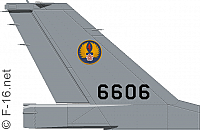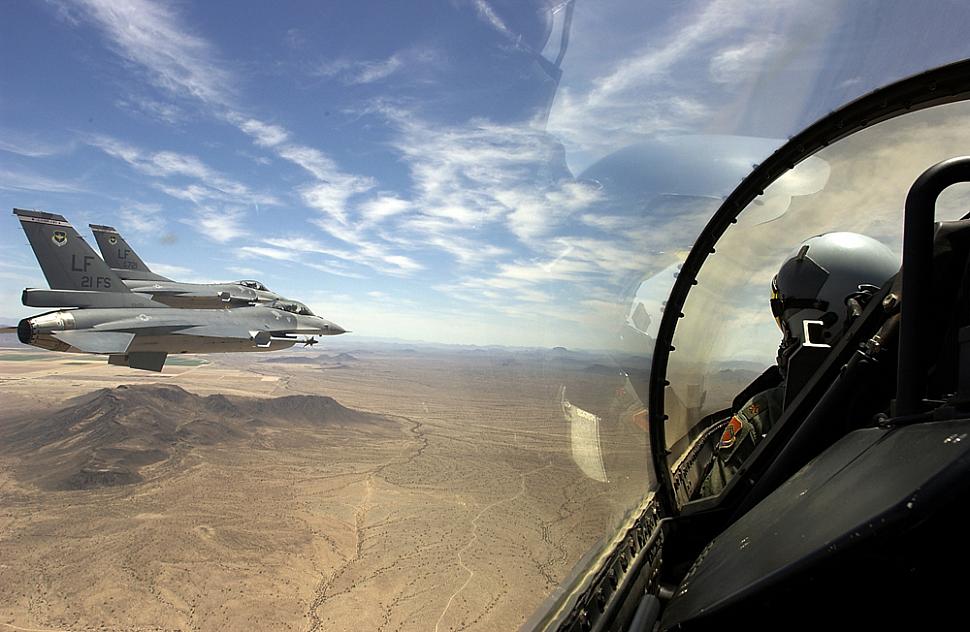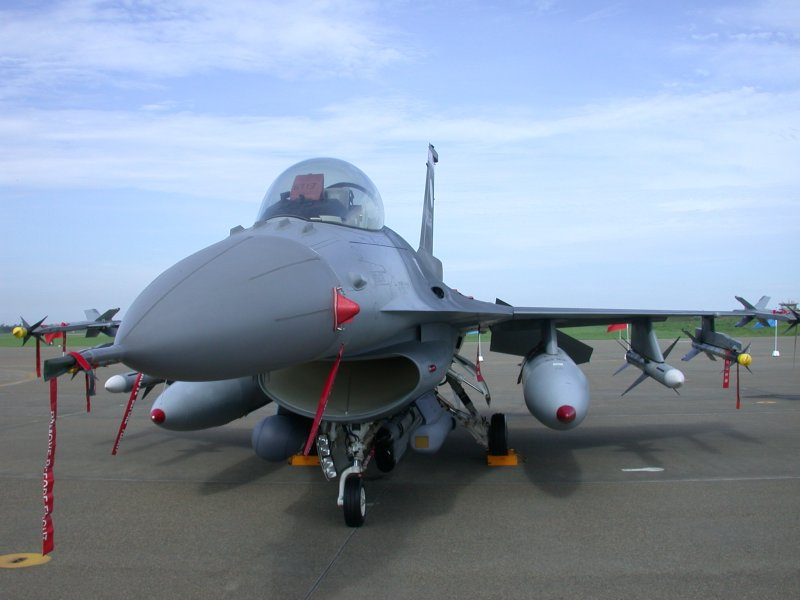 |
Republic of China / Taiwan
Chung-kuo Kung Chun
|
Introduction
The Republic of China Air Force operates a total of 150 F-16A/B block 20 aircraft, which are essentially identical to MLU aircraft. Taiwan is planning to acquire 66 F-16C/D block 70 aircraft in the near future, mainly to counter the perceived threat from mainland China.
Inventory
Peace Fenghuang
In November 1992, representatives of Taiwan and the United States signed an agreement for the sale of 150 F-16A/B aircraft (120 A-models and 30 B-models) to Taiwan under the Peace Fenghuang Foreign Military Sales program. This large order (which coincided with an order for 60 Mirage 2000-5 aircraft, as well as a planned production run of 130 IDF (Indigenous Defensive Fighter) aircraft was meant to replace Taiwan's aging fleet of F-104 and F-5E aircraft. The air force inventory modernization program fits in a general military modernization program, spurred by China's move to upgrade its military hardware.
The F-16s are F-16 block 15OCU's built to MLU specifications (but designated F-16 Block 20 however). By the start of 1997, 5 aircraft had already been built and were formally handed over to Taiwan. Total cost of the deal is supposedly USD $6 billion.
Twenty F-16A/B Block 20 aircraft are based in te US for testing and training purposes: 18 at Luke AFB as the 21st FS Gamblers, and 2 others (1 F-16A and 1 F-16B) were initially sent to the 416th FLTS at Edwards AFB for the Block 20 flight tests and MMC software tests. Later the 2 were sent to Fort Worth for follow up software tests and upgrades. As of 2006, 14 aircraft remain at Luke with also the 2 Edwards vipers still present.

New Order
In May 2006, Taiwan announced it was interested in purchasing an additional 66 F-16 aircraft. Taipei's first choice was to purchase the F-35 Joint Strike Fighters - which will come into service in the next few years - but the US has refused to offer Taiwan its newest fighters. Taiwan is buying the F-16 fighter jets to upgrade its aging air force fleet and counter what it perceives as a growing military threat from China.
On July 17th, 2006, the United States agreed to sell Taiwan 66 F-16 fighter jets in a deal worth over US $3 billion, the biggest arms deal the United States has offered Taiwan since 2001. In that year the US provided Taiwan with eight diesel-powered submarines, 12 P-3C submarine-hunting aircraft and PAC-3 Patriot missiles.
The new planes are aimed at replacing the ageing fleet of 60 Taiwanese F-5 aircraft who are serving for almost 30 years now. The deal is part of the Taiwanese Relations Act but is still a shift in US policy. Back in 1992, the US agreed to sell Taiwan 150 less sophisticated F-16A/Bs, but refused to provide F-16C/Ds which have a longer range and powerful ground attack capability.
The F-16 and Mirage-2000 fighters will remain in service for another 15 to 20 years but because of the gradual decommissioning of the aging F-5s over the coming years, the air force is expected to be short by more than 40 fighters in 2015. Hence they need to build a new fighter fleet to fill the vacuum. Even if Taiwan decides to purchase the aircraft this year, Taiwan won't see the aircraft until 2011-2012 due to paperwork and production timeline.
Ultimately this saga never went through, but evolved into a new order for block 70/72 aircraft in August of 2019. Originally planned to be delivered in 2023-2024, this timeframe has already slipped to 2026-2027 at the earliest due to impact of the COVID crisis and later on general supply chain issues.
| Program | Model | Block | Qty. | Serials | Delivered |
|---|---|---|---|---|---|
| Peace Fenghuang | F-16A | Block 20 | 120 | 6601/6720 | 1997-2001 |
| F-16B | Block 20 | 30 | 6801/6830 | 1997-2001 |
Modifications & Armament
Modifications
The Block 20's have the improved Westinghouse AN/APG-66(V) 3 fire-control radar (157 ordered), AN/APX-111 IFF, ALR-56M advanced radar warning receivers, and the AN/ALE-47 chaff/flare dispensers.
The cockpit is similar to that of block 50 aircraft, with night vision goggle compatibility, modular mission computer, GPS, Honeywell LCD color displays, and wide-angle HUDs. All ROCAF F-16s are powered by F100-PW-220 turbofan engines. It is worth noting that these F-16s will retain their in-flight refueling capabilities.
Armament & Stores
RoCAF F-16s are equipped with AIM-7M Sparrow, AIM-9M & P4 Sidewinder and AGM-65 Maverick missiles. Recently a batch of 120 AIM-120C-5 and also 54 AGM-84 Harpoon missiles were purchased from the USA to complement the existing weapons stock.
Instead of Westinghouse AN/ALQ-131 ECM pods, Taiwan chose the Raytheon AN/ALQ-184(V)7 ECM pods (80 ordered). The contract which includes 80 pods, plus support equipment and spares, represents the first foreign sale of the AN/ALQ-184, and is worth over $100 million.
There has been a long standing dispute with the US over various modifications to the F-16 such as integrating the local TC2 BVR missile and HF2 anti shipping missile. So far, the US has not allowed any modifications to be made.
Some F-16s have been equipped with the AN/VDS-5 reconnaissance pod.
In later years a number of new weapons were acquired and older ones upgraded. In 2003 a complementary batch of 182 AIM-9M-2 missiles were ordered. In 2007 an additional order for 218 AIM-120C-7 was placed together with 235 AGM-65G. Not much later being followed by an order for 60 AGM-84L missiles and an upgrade package to upgrade the existing stock of Harpoons from the AGM-84G to L-standards.

Sharpshooter/Pathfinder Targeting & Navigation pods
On June 3rd, 1998, the US Department of Defense announced that it is willing to provide Taiwan with 28 Pathfinder/Sharpshooter navigation and targeting pods. The deal is worth approx. US$160 million. Lockheed Martin Electronics & Missiles of Orlando, Florida will deliver 28 Sharpshooter targeting pods and 28 Pathfinder navigation pods for integration on Taiwan's fleet of F-16 aircraft by October 2001. Taiwan will become the 10th foreign customer to select Lockheed Martin's LANTIRN night vision system for its fighter aircraft. Pathfinder and Sharpshooter are derivatives of the LANTIRN system, which Lockheed Martin initially developed for US Air Force F-15E and F-16C/D fighters. On June 7th, 2000 a second order was placed for 39 pods of both Sharpshooter and Pathfinder systems.
Midlife Update
On September 2nd, 2011 it became apparant that the deal for 66 new aircraft wouldn't be executed in the short-term. Although the Taiwanese F-16s are build to MLU standards, they are becoming a bit absolete and certainly compaired with the new hardware mainland China has put into place over the past years. To counter this a $5.3 billion deal was put forward to update the existing F-16s. This update would replace the current MMC with the latest available model and some other systems to bring them on to par with the latest block 50/52 models. Most importantly this would also entail replacing the existing AN/APG-66(V)3 radar with an Active Electronically Scanned Array (AESA) radar (being either the Northrop Grumman's Scalable Agile Beam Radar or the Raytheon Advanced Combat Radar), incorporating an Embedded Global Positioning System/Inertial Navigation System and the Terma ALQ-213 Electronic Warfare Management System.
This deal also includes delivery of advanced targeting and bomb systems. Including either the Lockheed AN/AAQ-33 SNIPER Targeting System or the Northrop AN/AAQ-28 LITENING Targeting System for the first category and Boeing GBU-31, GBU-38 Joint Direct Attack Munitions (JDAMs) and also GBU-54 Laser-guided JDAM, GBU-10 Enhanced PAVEWAY II or GBU-24 Enhanced PAVEWAY III for the second. Besides that CBU-105 Sensor Fused Weapons and the new Raytheon AIM-9X Sidewinder air-to-air missile have also been approved.
Moreover the F-16A/B package will include an engineering and design study on possibly replacing the existing F100-PW-220 engines with F100-PW-229 engines.
In 2016 it became apparant that a larger update package was anticipated, covering most items previously mentioned (including the PF100-PW-229 engines). Lockheed expanded this package further ultimately becoming a new subblock. The package is called F-16V configuration, which is also represented as new-build block 70 airframes.
Operational Service
Units
Please refer to the F-16 Units section for an overview of units.Special thanks
- Alec Chen;
- Frankc C. Chen;
- Paul Chen;
- Ian Lamont;
- SkinnyBear;
- Eric Wenden;
- Eleven;
- Bryan Chen.
Please use this form to add any list any error or omissions you find in the above text.
Note: your comments will be displayed immediately on this page. If you wish to send a private comment to the webmasters, please use the Contact Us link.
